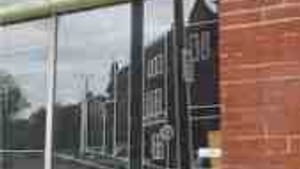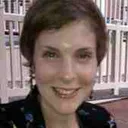Stay in the Loop
BSR publishes on a weekly schedule, with an email newsletter every Wednesday and Thursday morning. There’s no paywall, and subscribing is always free.
Is Powelton Village the next Greenwich Village?
"Look! on Lancaster Avenue'

"Look! on Lancaster Avenue," a two-month public art display, seeks to open Philadelphians' eyes to the beauty, creativity and energy currently emerging in an often-overlooked neighborhood. Powelton Village has always labored in the shadow of Penn's surrounding University City district, for better or worse.
While Powelton hasn't experienced University City's frictions between an old neighborhood and an expanding college student population, neither has it benefited from the attention (or dollars) that such expansion brings. Drexel University has tried to apply more subtle approaches to rejuvenate its depressed surrounding Powelton neighborhood (such as public art displays), but that subtlety will require time, diligence and patience if it is to ever succeed.
Truth is, Powelton Village has been populated for decades by a vibrant, talented and insular group of artists. The Community Education Center in Powelton is known for the quality of its dance classes and its effectiveness at reaching broad audiences. Randy Dalton, one of the CEC's founders, is an artist himself, whose work is featured in Philadelphia's Project I Gallery.
Why, then, has Powelton's creative energy remained under most Philadelphians' radar?
Perhaps a neighborhood can't really thrive without public spaces and occasions for groups to socialize and attract new participants. New voices need to join with existing community visionaries in order for any change to take place. They need a place to eat, drink and get to know one another.
In search of buzz
Last Friday's opening reception of for "Look"— sponsored by Drexel University, University City District and the People's Emergency Center— sought to create that kind of public buzz. It was a "First Friday" type event, with the combination of street performers, music and open galleries familiar to denizens of Old City.
My friends and I headed for dinner to Lemongrass, a local Thai restaurant, before checking out the galleries. Neither the restaurant nor the sidewalks were overflowing with pedestrians, but it was quite a scene for a neighborhood that's largely vacant on any given Friday. The evening's events included roving performers, spoken word poets and hip bands channeling Tom Waits.
As we strolled up Lancaster Avenue, the pieces of public art stood out nicely against the decaying facades of gorgeous old storefronts and slightly dilapidated apartment buildings. Clinging to the brick walls of 3826, Russell Mahoney and Emil Crystal's "armature" fabric triangles surprised passersby with their obvious artistic (although clearly undefined) intentions.
Impeded by scaffolding
Peering into the storefronts from 35th to 40th streets, we ambled along Lancaster Avenue and were met with eerie light installations and bits of colorful detritus pasted to large glass windows. Scaffolding impeded the sidewalk at times, adding an appropriate element of construction and development to the event. Property owners, old locals and a few new faces dotted the sidewalks, despite the rain and chilly temperatures.
We first ducked into Viorel Farcas's Gallery, filled with his gracefully grotesque bronze sculptures perched on delicate wooden stools. What a contrast to the decayed and slightly psychedelic aesthetic of the art on the street!
Farcas, with a sculpture's unpretentious smile, served wine and chatted with the sparse crowd. His sculptures were otherworldly and beautiful, like Degas ballerinas grown old, decrepit and over-stretched. We left in awe, inspired to see what other fine work could be found along the avenue.
Faces of Jesus
And we weren't disappointed. Blaise Tobia's gallery was filled with works by Tobia and four other artists, including photographs by Thomas Gartside that also stressed the beauty of new grown old.
One of my favorite series here featured Gartside's close-up shots of decaying statues of Jesus's downturned face on the cross. I've gazed at these old Jesus likenesses so often— on the street, in local churches, flashing through old Italian films— that I'd forgotten their prevalence and their beauty.
What does it mean to look at the old through new artistic media? How is the old transformed, and what does it tell us about our notions of beauty? The beauty of nostalgia fills our lives; Tobia's photographs capitalize on these ubiquitous symbols of time transforming bodies and spaces.
Perhaps one of my favorite stops was 3818, whose window was filled with fun antiques, including an army of plastic alligators and a robot composed of various rusty toys. Inside was a crowd of Powelton locals, all of whom clearly knew one another, and all of whom were clearly excited by the new energy and attention that was being paid to the area. Men and women caroused in strange hats, artists in handkerchiefs sipped expensive drinks in small plastic cups, and all the while artifacts from a life spent dedicated to an artistic passion surrounded us.
I couldn't help but wonder: Who were these people? Why didn't I know of the quirky art and people that populate Lancaster Avenue?
Fear of crime
One obvious answer is that outsiders are afraid of Lancaster Avenue— it's close to reported violence, drugs and poverty. It lacks a critical mass of restaurants capable of attracting outsiders.
What's also missing are gathering places like coffee houses, interesting bars, health food stores, clothing boutiques. Once you've visited a gallery, there's nowhere to go but a Starbucks in University City.
Lancaster Avenue suffers from a kind of precious and slightly pretentious artistic purity that will make growth slow and, perhaps, more authentic. Its residents seem to prefer it that way. But if Drexel wants Powelton Village to emulate University City, more energy and money must be invested.
For now, Powelton's old and the new coexist in a beautifully intimate sense of neighborhood and artistic authenticity that could be easily soiled by too many corporate dollars. Here's hoping this kind of "First Friday" event happens again, and soon, before folks forget about Lancaster Avenue once again.♦
To read a response, click here.
While Powelton hasn't experienced University City's frictions between an old neighborhood and an expanding college student population, neither has it benefited from the attention (or dollars) that such expansion brings. Drexel University has tried to apply more subtle approaches to rejuvenate its depressed surrounding Powelton neighborhood (such as public art displays), but that subtlety will require time, diligence and patience if it is to ever succeed.
Truth is, Powelton Village has been populated for decades by a vibrant, talented and insular group of artists. The Community Education Center in Powelton is known for the quality of its dance classes and its effectiveness at reaching broad audiences. Randy Dalton, one of the CEC's founders, is an artist himself, whose work is featured in Philadelphia's Project I Gallery.
Why, then, has Powelton's creative energy remained under most Philadelphians' radar?
Perhaps a neighborhood can't really thrive without public spaces and occasions for groups to socialize and attract new participants. New voices need to join with existing community visionaries in order for any change to take place. They need a place to eat, drink and get to know one another.
In search of buzz
Last Friday's opening reception of for "Look"— sponsored by Drexel University, University City District and the People's Emergency Center— sought to create that kind of public buzz. It was a "First Friday" type event, with the combination of street performers, music and open galleries familiar to denizens of Old City.
My friends and I headed for dinner to Lemongrass, a local Thai restaurant, before checking out the galleries. Neither the restaurant nor the sidewalks were overflowing with pedestrians, but it was quite a scene for a neighborhood that's largely vacant on any given Friday. The evening's events included roving performers, spoken word poets and hip bands channeling Tom Waits.
As we strolled up Lancaster Avenue, the pieces of public art stood out nicely against the decaying facades of gorgeous old storefronts and slightly dilapidated apartment buildings. Clinging to the brick walls of 3826, Russell Mahoney and Emil Crystal's "armature" fabric triangles surprised passersby with their obvious artistic (although clearly undefined) intentions.
Impeded by scaffolding
Peering into the storefronts from 35th to 40th streets, we ambled along Lancaster Avenue and were met with eerie light installations and bits of colorful detritus pasted to large glass windows. Scaffolding impeded the sidewalk at times, adding an appropriate element of construction and development to the event. Property owners, old locals and a few new faces dotted the sidewalks, despite the rain and chilly temperatures.
We first ducked into Viorel Farcas's Gallery, filled with his gracefully grotesque bronze sculptures perched on delicate wooden stools. What a contrast to the decayed and slightly psychedelic aesthetic of the art on the street!
Farcas, with a sculpture's unpretentious smile, served wine and chatted with the sparse crowd. His sculptures were otherworldly and beautiful, like Degas ballerinas grown old, decrepit and over-stretched. We left in awe, inspired to see what other fine work could be found along the avenue.
Faces of Jesus
And we weren't disappointed. Blaise Tobia's gallery was filled with works by Tobia and four other artists, including photographs by Thomas Gartside that also stressed the beauty of new grown old.
One of my favorite series here featured Gartside's close-up shots of decaying statues of Jesus's downturned face on the cross. I've gazed at these old Jesus likenesses so often— on the street, in local churches, flashing through old Italian films— that I'd forgotten their prevalence and their beauty.
What does it mean to look at the old through new artistic media? How is the old transformed, and what does it tell us about our notions of beauty? The beauty of nostalgia fills our lives; Tobia's photographs capitalize on these ubiquitous symbols of time transforming bodies and spaces.
Perhaps one of my favorite stops was 3818, whose window was filled with fun antiques, including an army of plastic alligators and a robot composed of various rusty toys. Inside was a crowd of Powelton locals, all of whom clearly knew one another, and all of whom were clearly excited by the new energy and attention that was being paid to the area. Men and women caroused in strange hats, artists in handkerchiefs sipped expensive drinks in small plastic cups, and all the while artifacts from a life spent dedicated to an artistic passion surrounded us.
I couldn't help but wonder: Who were these people? Why didn't I know of the quirky art and people that populate Lancaster Avenue?
Fear of crime
One obvious answer is that outsiders are afraid of Lancaster Avenue— it's close to reported violence, drugs and poverty. It lacks a critical mass of restaurants capable of attracting outsiders.
What's also missing are gathering places like coffee houses, interesting bars, health food stores, clothing boutiques. Once you've visited a gallery, there's nowhere to go but a Starbucks in University City.
Lancaster Avenue suffers from a kind of precious and slightly pretentious artistic purity that will make growth slow and, perhaps, more authentic. Its residents seem to prefer it that way. But if Drexel wants Powelton Village to emulate University City, more energy and money must be invested.
For now, Powelton's old and the new coexist in a beautifully intimate sense of neighborhood and artistic authenticity that could be easily soiled by too many corporate dollars. Here's hoping this kind of "First Friday" event happens again, and soon, before folks forget about Lancaster Avenue once again.♦
To read a response, click here.
What, When, Where
"LOOK! on Lancaster Avenue." Through November 30, 2011 at various locations on Lancaster Ave. between 34th and 41st Streets in West Philadelphia. www.lancasteravenuearts.com.
Sign up for our newsletter
All of the week's new articles, all in one place. Sign up for the free weekly BSR newsletters, and don't miss a conversation.

 Madeline Schaefer
Madeline Schaefer